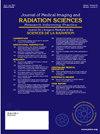Child-sizing Imaging and Interventions – Making challenges fun!
IF 1.3
Q3 RADIOLOGY, NUCLEAR MEDICINE & MEDICAL IMAGING
Journal of Medical Imaging and Radiation Sciences
Pub Date : 2024-10-01
DOI:10.1016/j.jmir.2024.101470
引用次数: 0
Abstract
“Children are not small adults” – Many assumptions that we apply when performing imaging and interventions in adults do not hold true when applied in children. Children are more susceptible to the deleterious effect of radiation when compared to adult, especially in terms of cancer-risk associated with radiation. While the average radiation dose involved in medical imaging is significantly lower than that in radiation therapy, it is important for us to adopt the “As Low As Reasonably Appropriate” (ALARA) principle. When performing medical imaging with ionizing radiation, we need to use appropriate strategies to limit the radiation dose. Also, we need to consider alternative radiation-free imaging modalities, such as ultrasound and magnetic resonance imaging (MRI). MRI is the preferred imaging modality for many childhood conditions, given its high soft tissue contrast resolution and lack of ionizing radiation. The trade-off for performing MR scans is the relatively long scan time, during which the child would have to stay still and motionless. Motion artifacts result in poor image quality and potentially non-interpretable scans.
In order to keep young children still for MR scans, sedation or anaesthesia services are often required. While sedation is relatively safe in experienced hands, the risk to the patient is higher than that of non-sedated MRI because of the possibility of adverse reactions to medications, cardiovascular or respiratory events, as well as growing concerns regarding potential adverse neurocognitive effects associated with exposure to anaesthetic medications early in life. In addition, anaesthesia service is a scarce resource in most hospitals and often creates a bottleneck effect in examination scheduling, i.e. MR scans with sedation often have longer wait times than non-sedated MR studies.
Depending on the age of the child, various non-sedative strategies can be used to reduce need for sedation or anaesthesia. To run a successful non-sedated MR program, it involves collaborative teamwork between radiologist, MR technologists, referring clinical team, anaesthesiologists, play specialists and, most important, the child and his/her parent. This multidisciplinary team effort ensures proper patient selection, MR scan protocoling and creation of a child-friendly environment.
For baby aged less than 6 months, “feed-and-sleep” can be used to reduce the need of pharmacological sedation. With this technique, we make use of patients' daily feed and natural sleep pattern to let the baby fall asleep before start scanning. The parents would be briefed beforehand on when to feed the patient and the scan would be scheduled to fit with the feed schedule. The infant would be wrapped tightly in a pneumatic blanket to ensure comfort and minimise movement. The MR scanning room ambient light would be dimmed and “quieter” MR sequences would be selected to avoid waking the patient up.
Older children from 3 to 6 years old can avoid pharmacological sedation with the “Mock Scan MRI” programme, which was created in collaboration with play specialists. The mock scanner simulates the MRI experience including the noises the scanner makes. Selected patients are individually invited to a mock scan, during which education and training are provided to the child and parents. At the same time, the compliance level of the child is also assessed.
In addition to Mock MRI scan, MR-compatible video goggles can be worn by the child during scanning to provide audiovisual distraction. In our hospital, we provide a selection of movies for the child to select before he/she hops on the scanner. If the child is nervous, the parent and/or child play specialist may also be invited to accompany the child into the scanning room.
Finally, interventional Radiology (IR) has revolutionised the management of childhood diseases. With its minimally invasive nature, image-guided interventions are now the standard of care for many procedures which are traditionally delivered by paediatric surgeons, including vascular access, tumour biopsies and enteric access. Moving into the realm of interventional oncology, IR also has a growing role to play in management of locoregional tumour control through thermal ablative therapies and chemo-embolisation.
儿童尺寸成像和干预--让挑战充满乐趣!
"儿童不是小大人"--我们在对成人进行成像和干预时所采用的许多假设在儿童身上并不适用。与成人相比,儿童更容易受到辐射的有害影响,尤其是在与辐射相关的癌症风险方面。虽然医学影像所涉及的平均辐射剂量明显低于放射治疗,但我们必须遵循 "合理适当的最低剂量"(ALARA)原则。在使用电离辐射进行医学成像时,我们需要使用适当的策略来限制辐射剂量。此外,我们还需要考虑其他无辐射成像模式,如超声波和磁共振成像(MRI)。磁共振成像具有软组织对比分辨率高和无电离辐射的特点,是许多儿童疾病的首选成像方式。进行核磁共振扫描的代价是扫描时间相对较长,在此期间患儿必须保持静止不动。运动伪影会导致图像质量不佳,并可能导致扫描结果无法解读。为了让幼儿在磁共振扫描时保持静止,通常需要使用镇静剂或麻醉服务。虽然镇静在有经验的医生手中是相对安全的,但由于可能出现药物不良反应、心血管或呼吸系统事件,以及越来越多的人担心在生命早期接触麻醉药物可能会对神经认知产生不良影响,因此对患者造成的风险高于无镇静磁共振成像。此外,麻醉服务在大多数医院都是稀缺资源,往往会在检查时间安排上产生瓶颈效应,即使用镇静剂进行磁共振扫描的等待时间往往长于非镇静磁共振检查。要成功实施非镇静 MR 计划,需要放射科医生、MR 技术人员、转诊临床团队、麻醉科医生、游戏专家以及最重要的儿童及其家长之间的团队合作。这种多学科团队合作确保了患者的正确选择、磁共振扫描方案的制定以及儿童友好环境的营造。对于 6 个月以下的婴儿,可以使用 "喂食-睡眠 "来减少药物镇静的需要。对于 6 个月以下的婴儿,可以采用 "喂食-睡眠 "的方法,减少药物镇静的需要。我们利用患者的日常喂食和自然睡眠模式,让婴儿在扫描开始前入睡。我们会事先向家长说明何时喂奶,并根据喂奶时间安排扫描。婴儿会被气动毯紧紧包裹,以确保舒适并尽量减少移动。核磁共振扫描室的环境光线会变暗,并选择 "较安静 "的核磁共振序列,以避免吵醒病人。3 到 6 岁的较大儿童可以通过与游戏专家合作创建的 "模拟扫描核磁共振 "项目避免药物镇静。模拟扫描仪可模拟核磁共振成像体验,包括扫描仪发出的噪音。被选中的患者会被单独邀请进行模拟扫描,在扫描过程中会对儿童和家长进行教育和培训。除了模拟核磁共振扫描外,儿童还可以在扫描过程中佩戴核磁共振兼容视频护目镜,以分散视听注意力。在我们医院,我们会在孩子跳上扫描仪之前提供一些电影供其选择。最后,介入放射学(IR)彻底改变了儿童疾病的治疗方法。影像引导下的介入治疗具有微创性,现已成为许多传统上由儿科外科医生实施的手术的标准治疗方法,包括血管通路、肿瘤活检和肠道通路。进入肿瘤介入领域后,图像引导介入技术在通过热烧蚀疗法和化疗栓塞控制局部肿瘤方面也发挥着越来越重要的作用。
本文章由计算机程序翻译,如有差异,请以英文原文为准。
求助全文
约1分钟内获得全文
求助全文
来源期刊

Journal of Medical Imaging and Radiation Sciences
RADIOLOGY, NUCLEAR MEDICINE & MEDICAL IMAGING-
CiteScore
2.30
自引率
11.10%
发文量
231
审稿时长
53 days
期刊介绍:
Journal of Medical Imaging and Radiation Sciences is the official peer-reviewed journal of the Canadian Association of Medical Radiation Technologists. This journal is published four times a year and is circulated to approximately 11,000 medical radiation technologists, libraries and radiology departments throughout Canada, the United States and overseas. The Journal publishes articles on recent research, new technology and techniques, professional practices, technologists viewpoints as well as relevant book reviews.
 求助内容:
求助内容: 应助结果提醒方式:
应助结果提醒方式:


